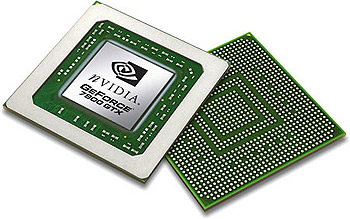The polygons making up 3D rendered foliage and
fences use transparency (alpha) effects to allow realistic sight lines
through them, but this means that the pixels making up the visible edge of
a blade of grass or leaf are not always on the edge of their polygon, but rather
somewhere inside it next to other pixels which have been made
transparent. Multi-sampling AA will not smooth out these
pixels, meaning that textures that use transparencies will always
appear to be jaggy, even in an otherwise glass-smooth 8xAA sampled
scene.
The other common method of Anti-Aliasing,
SuperSampling, can solve this problem in a way. SuperSampling
renders each entire frame at a higher resolution then blends the
colour and shade of areas where there is a large amount of difference between
pixels, then re-renders the image at the display resolution. Supersampling
does not care whether it is blending pixels at the edges of polygons or in the
middle of them. The disadvantage though, is that supersampling incurs a
huge performance hit, making it difficult to justify.
nVidia's TRSS and TRMS AA technologies provide a
more elegant solution. Transparency Adaptive Multi-sampling performs the
same AA operations as conventional multi-sampling does, blending pixels on
the edges of polygons. It then goes one step further by examining each
polygon for pixels with alpha (transparency) information. If it finds
them, it applies AA to the pixels adjacent to the transparent
areas too.
As far as we can tell, Transparency adaptive SuperSampling performs
simple multi-sampling on most of the image as normal, but
applies full supersampling to polygons with alpha pixels in them. This results
in higher image quality and a larger performance hit than TRMS.
 In all, TRSS and TRMS seem like a sensible upgrade
to current AA technologies, enabling better all-around image quality without the
performance hit associated with full supersampled AA. Games like Far Cry
and Half-Life 2 should benefit considerably from nVidia's new tech.
In all, TRSS and TRMS seem like a sensible upgrade
to current AA technologies, enabling better all-around image quality without the
performance hit associated with full supersampled AA. Games like Far Cry
and Half-Life 2 should benefit considerably from nVidia's new tech.
SLI of the future
The GeForce 7800GTX will be fully SLI compatible,
as evidenced by the reference card. The potential of this unholy union
should have game fanatics drooling. Apparently, future versions of
nVidia's Forceware will also allow SLI with cards from different
manufacturers (provided they use the same GPU). With the current
drivers, this is possible but not all the time.
Also in store for SLI enthusiasts with future
Forceware versions is a new 16xAA mode. The video memory requirements for
16xAA are huge, so it's no surprise that nVidia has chosen to restrict it
to SLI. Once we begin to see videocards shipping with 512MB of memory as a
standard, 16xAA might move into the mainstream.
Purevideo: not new, but
improved
The nVidia PureVideo video capture/playback
technology that debuted on the 6xxx line of GPUs is back on the 7800 with some
enhancements and a new feature. The new feature is High-Definition
Spatial-Temporal De-Interlacing
, a mouthful which boils down to better high-definition video
playback.
The additional horsepower of the 7800GPU is used to
improve other facets of video playback and capture also, which should lead to
the new graphics processor being a mean multimedia machine.
